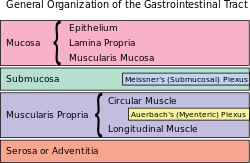
Back ضفيرة عضلية معوية Arabic Myenterický plexus Czech Plexus myentericus German Plexo mientérico Spanish Plexus Auerbach ID Plesso di Auerbach Italian アウエルバッハ神経叢 Japanese 근육층신경얼기 Korean Splot Auerbacha Polish Plexo mioentérico Portuguese
| Myenteric plexus | |
|---|---|
 The myenteric plexus from the rabbit. X 50. | |
 | |
| Details | |
| Identifiers | |
| Latin | plexus myentericus, plexus Auerbachi |
| MeSH | D009197 |
| TA98 | A14.3.03.041 |
| TA2 | 6727 |
| Anatomical terms of neuroanatomy | |
 |
| This article is one of a series on the |
| Gastrointestinal wall |
|---|
The myenteric plexus (or Auerbach's plexus) provides motor innervation to both layers of the muscular layer of the gut, having both parasympathetic and sympathetic input (although present ganglion cell bodies belong to parasympathetic innervation, fibers from sympathetic innervation also reach the plexus), whereas the submucous plexus provides secretomotor innervation to the mucosa nearest the lumen of the gut.
It arises from cells in the vagal trigone also known as the nucleus ala cinerea, the parasympathetic nucleus of origin for the tenth cranial nerve (vagus nerve), located in the medulla oblongata. The fibers are carried by both the anterior and posterior vagal nerves. The myenteric plexus is the major nerve supply to the gastrointestinal tract and controls GI tract motility.[1]
According to preclinical studies, 30% of myenteric plexus' neurons are enteric sensory neurons, thus Auerbach's plexus has also a sensory component.[2][3]
- ^ Human Anatomy and Physiology, Marieb & Hoehn, seventh edition[page needed]
- ^ Handbook of Experimental Pharmacology, Vol. 194: Sensory Nerves, Brendan J. Canning, Domenico Spina. Springer. Page 341.
- ^ Costa, M; Brookes, S. J.; Hennig, G. W. (2000). "Anatomy and physiology of the enteric nervous system". Gut. 47 (90004): iv15–9, discussion iv26. doi:10.1136/gut.47.suppl_4.iv15. PMC 1766806. PMID 11076898.